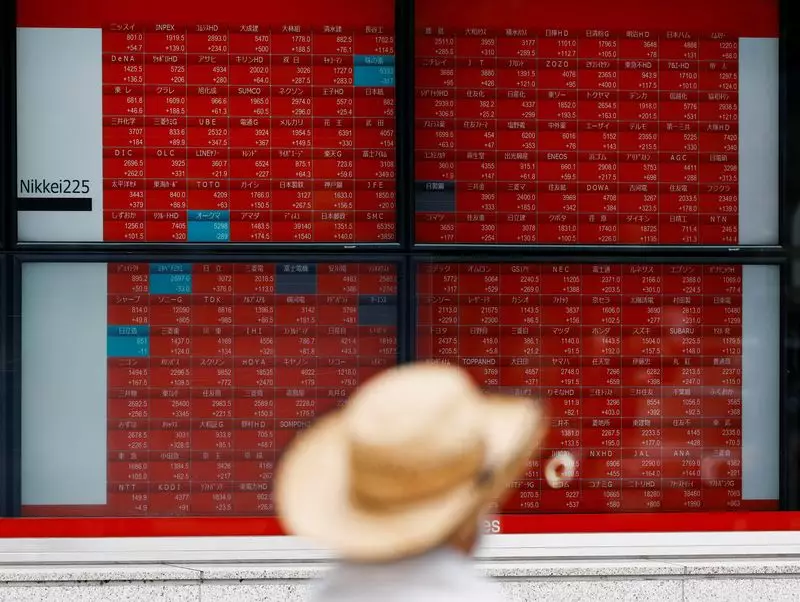In recent trading sessions, Japanese stocks exhibited substantial gains, reflecting investor optimism as perceptions around monetary policy began to shift. The Nikkei 225 index recorded a notable rise of 2.2%, driven primarily by the waning fears of imminent interest rate hikes in Japan. As the yen depreciated against the dollar—trading at approximately 146.84 yen—the outlook for Japanese exporters improved, contributing to the surge in equity markets. This movement suggests a growing confidence among investors regarding Japan’s economic recovery.
The backdrop of this upward momentum can be largely attributed to recent comments from key Japanese policymakers. Newly-elected Prime Minister Shigeru Ishiba stated that Japan currently lacks the readiness for further rate adjustments, easing concerns over aggressive monetary tightening. Additionally, Bank of Japan (BOJ) Governor Kazuo Ueda echoed sentiments of caution, emphasizing a patient approach to monetary policy decisions. This dovish rhetoric, particularly from influential figures within the BOJ, quenches speculation about rate hikes in the near term, with forecasts now suggesting potential increases may not materialize until 2025.
Conversely, the euro experienced significant pressures, trading at levels not witnessed since early September. Markets began to speculate on the European Central Bank (ECB) potentially cutting interest rates in its upcoming meetings in October and December. This sentiment was reinforced by remarks from Isabel Schnabel, a prominent member of the ECB’s governing council, signaling expectations for inflation to revert to target levels. The market’s recalibration of ECB rate hike probabilities has placed the euro under strain, reflecting a broader uncertainty surrounding European economic stability.
The euro’s decline, coupled with expectations of lower rates, positions currency traders on high alert. A dip below critical support levels could intensify selling pressure, leading to further downward adjustments. Investors are keenly watching any economic indicators that could influence ECB policy decisions, including consumer sentiment and inflation rates, in hopes of gaining insight into the eurozone’s trajectory.
Meanwhile, shares in Hong Kong experienced a pullback following a robust three-week surge that catapulted the Hang Seng Index upwards by 30%. The index fell by 2.5% in the latest session—an expected correction after an explosive rally triggered by the Chinese government’s aggressive stimulus measures aimed at revitalizing a struggling economy. While the pullback indicates profit-taking by investors, the broader narrative remains one of cautious optimism about the recovery of China’s economic activity post-COVID.
The fluctuations in Hong Kong’s market are also a testament to the lingering volatility in the region due to ongoing geopolitical tensions. As investments fluctuate based on sentiment rather than fundamentals, market participants are navigating a landscape fraught with uncertainty.
Over in the United States, market activity displayed a mixed picture. Despite a less volatile performance from Wall Street, rising Treasury yields underscore the continuous debate regarding the health of the U.S. labor market. A recent robust private payrolls report has buoyed confidence in the U.S. economy; however, traders are keeping a close watch on non-farm payrolls data anticipated soon.
As geopolitical tensions threaten to loom larger, evidenced by recent conflicts in the Middle East, there is increasing demand for safe-haven assets, directing capital flows towards Treasury securities. While the outlook suggests a 36% chance of further rate cuts by the Federal Reserve by November, investor sentiment may shift significantly based on forthcoming economic indicators.
Compounding these financial dynamics is the oil market, where prices have risen in response to fears over potential supply disruptions tied to escalating geopolitical strife. Brent crude futures climbed to approximately $74.68 per barrel, reflecting anxiety over future production from major oil-exporting nations.
The interdependencies among global markets underline the complexity of current financial environments. Investor sentiment swings driven by rhetoric and economic data continue to shape the trajectory of assets across diverse markets, illustrating the nuanced relationships that define the global economic landscape. As we navigate through these turbulent times, stakeholders will remain vigilant in their assessments, prepared to respond to emerging trends and unforeseen developments.

